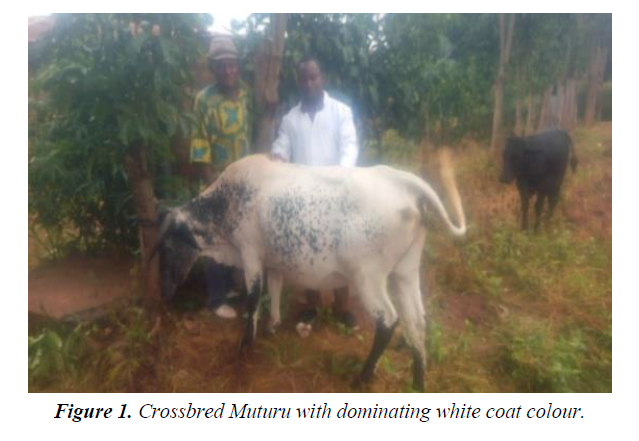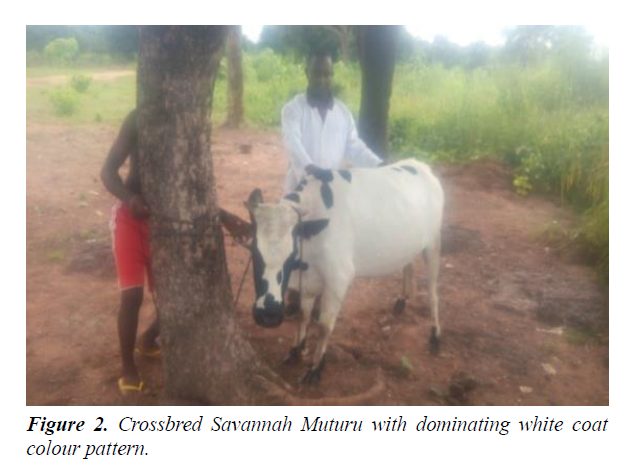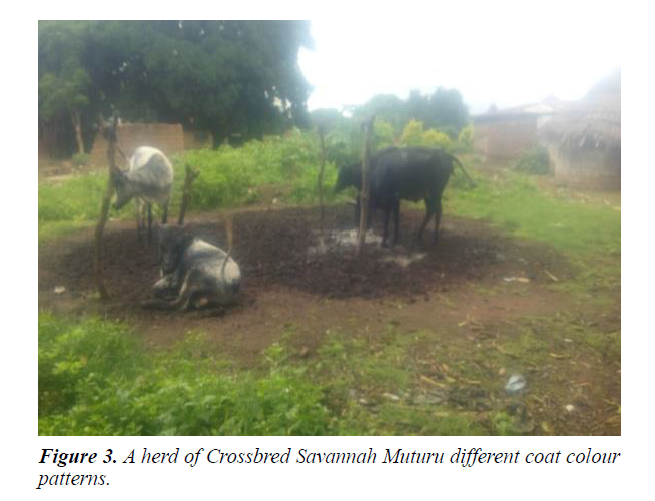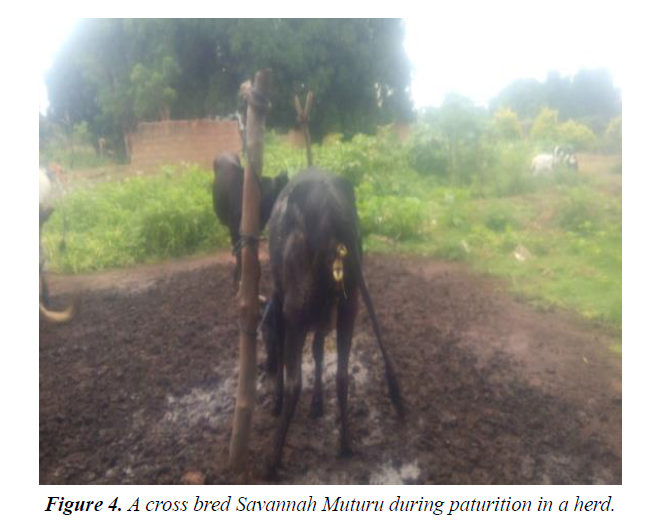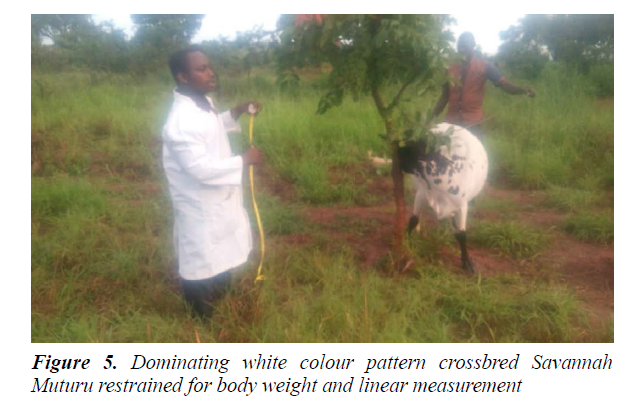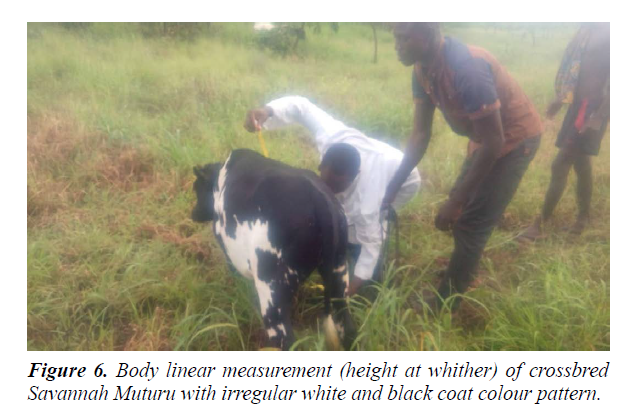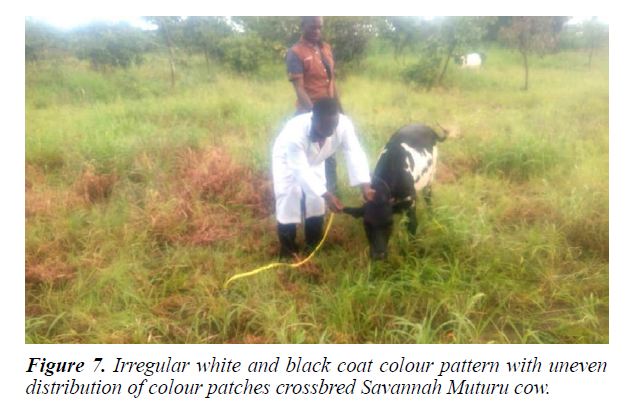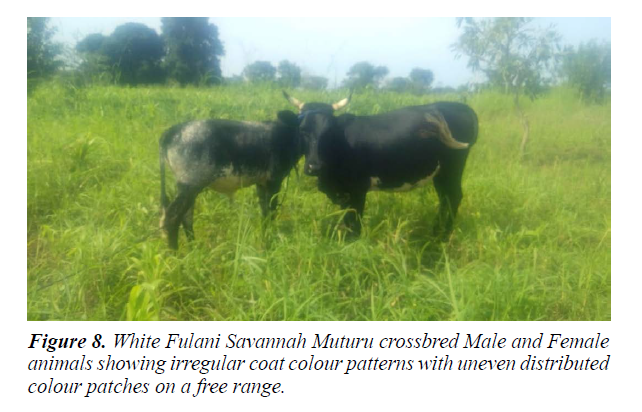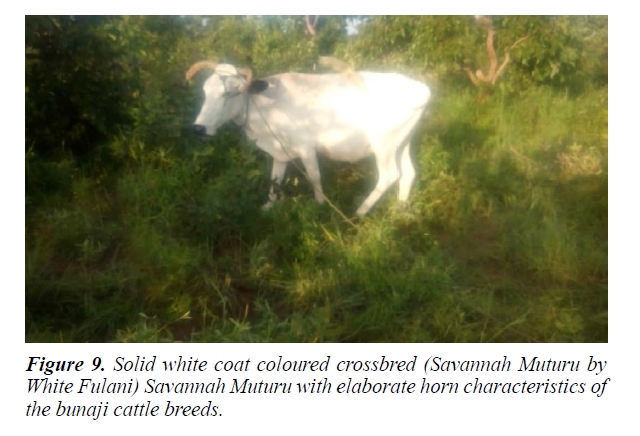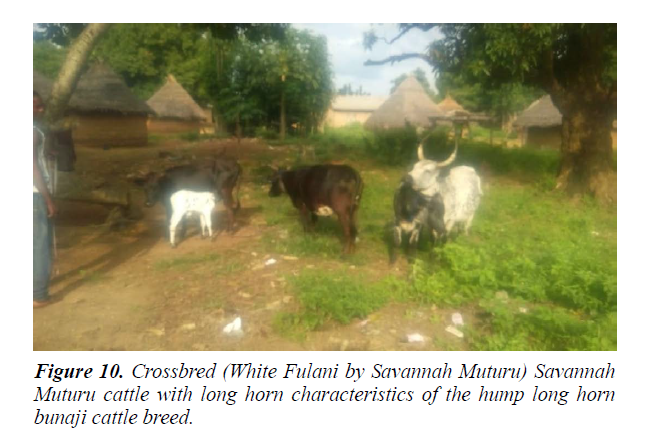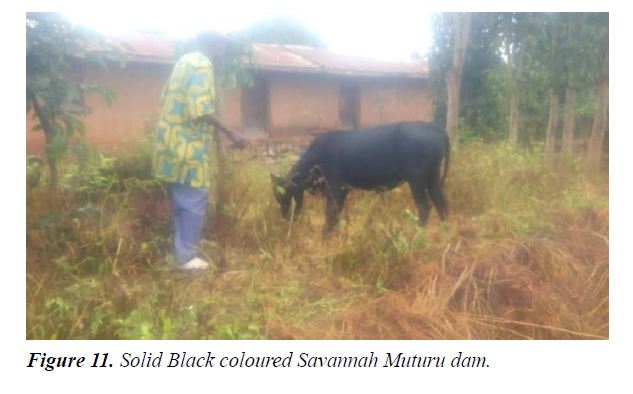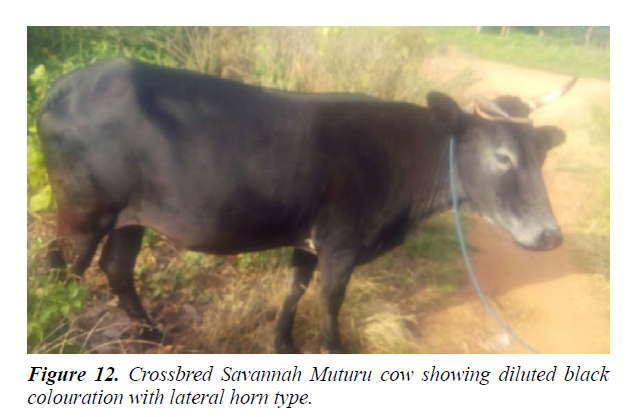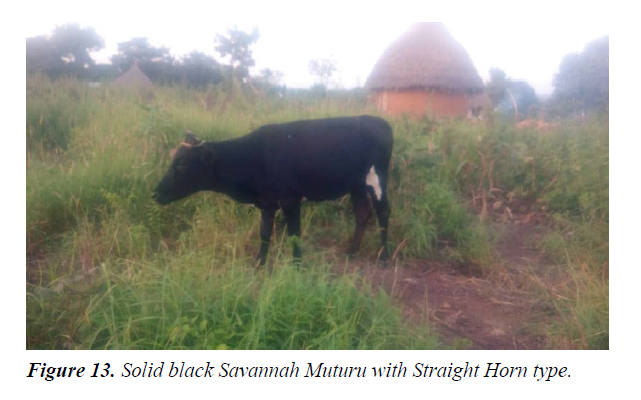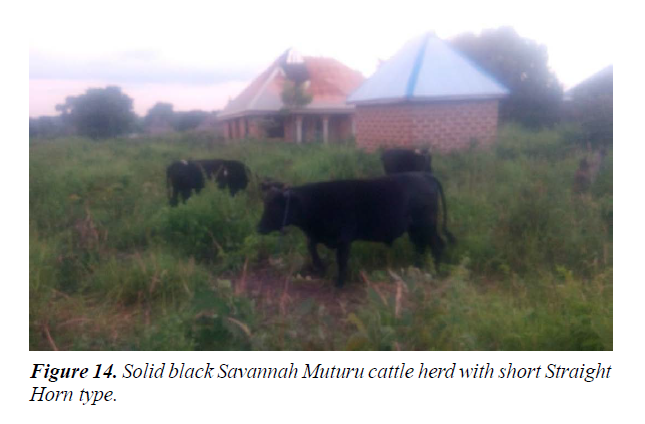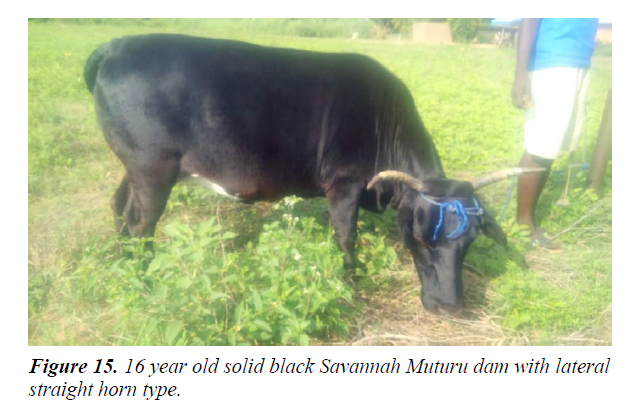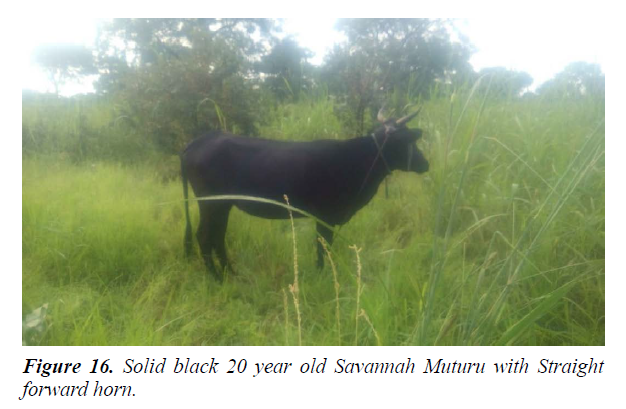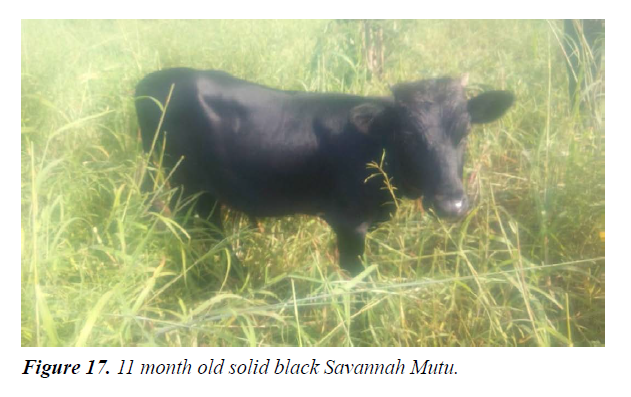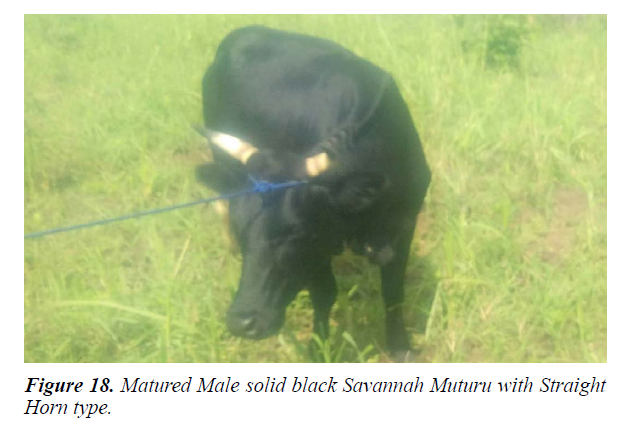Research Article - Research and Reports on Genetics (2019) Volume 3, Issue 2
Effect of interaction between economic driving force, value chain intervention, communal crisis and uncontrolled breeding on genetic resource abundance of the Nigerian savannah muturu cattle.
Gwaza DS*, Yahaya A
Department of Animal Breeding and Physiology, University of Agriculture, Makurdi, Nigeria
- *Corresponding Author:
- Gwaza DS
Department of Animal Breeding and Physiology
University of Agriculture
Nigeria
Tel: 08036808979
E-mail: gwazadeeve@yahoo.com
Accepted Date: July 24, 2018
Citation: Gwaza DS, Yahaya A. Effect of interaction between economic driving force, value chain intervention, communal crisis and uncontrolled breeding on genetic resource abundance of the Nigerian savannah muturu cattle. J Res Rep Genet. 2018;2(2):29-37.
Abstract
The study was conducted to assess the genetic resources abundance of the savannah muturu cattle in Nigeria. The study was carried out in five Local Government Areas of Benue State, known to rear savannah muturu cattle in Nigeria. Information was obtained from Muturu farmers and farmers known to rear Muturu breed. Data collected were analysed using SPSS statistical software. The result shows that inbreeding, indiscriminate cross breeding, communal crisis, low prices and pricing ,occasional demands and lack of value chain intervention and value addition were major factors affecting the genetic resource abundance of the Nigerian savannah muturu cattle. The results also revealed that lack of economic driving force or motivation, lack of value chain intervention, communal crisis, were the challenges that hindered the expansion of the Muturu herd sizes among rural farmers. Analysis of body weight and body linear measurement revealed that the genetic resources of the savannah muturu cattle had been diluted through crossbreeding with the zebu cattle. The small herd sizes maintained among rural farmers had undergone extensive inbreeding. There were losses of morphological colour characteristics of multiple black and white colour patches of equal dimensions and distribution over the entire body to colour restrictions of white, brown white and multiple colour patches of unequal dimensions and distributions over the entire body. Other herds still has animals that maintain the multiple colours patches of white and black of equal dimensions and distribution over the entire body. It was noted that the genetic resource abundance of the savannah muturu cattle among rural farmers is been eroded by these challenges mentioned above. There is need to introduce feed supplementation by use of crop residues and kitchen waste as fattening strategies, castration of unwanted bulls, reduction of inbreeding and crossbreeding with the Bunaji cattle breed, target mass production to festive periods and processing of finished Muturu animals to be slaughtered for retail sales. Identify specific value chain points along the production cycle,to improve Muturu cattle performance and value as a motivation to encourage rural farmers to expand their Muturu herds. It was evident that savannah muturu cattle is on it journey to extinction unless value addition services and value chain intervention methods are applied to encourage and attract more farmers into production of the breed in other to enhance it sustain use “the best conservation strategy”
Keywords
Communal-crisis, Economic-driving-force, Genetic-resources, Savannah-Muturu, Uncontrolled-breeding, Value-chain.
Introduction
The potentials of the indigenous livestock breeds among rural communities cannot be over-emphasized due to their special genetic trait for adaptation, survival and performance in a wide range of stressful production environment [1]. However, these genetic resources are often faced with challenges in the rural areas, as often performance records are not available for genetic evaluation, herd sizes are small which hinders effective selection for genetic improvement. The rate of inbreeding among the small populations is also very high that leads to gene dilution and inbreeding depression. The small herd sizes also encourage loss of potential alleles due to random sampling, genetic drift and mutation. The Muturu cattle are the smallest cattle breed in Nigeria, the animals are small, hardy, compact and trypanotolerant [2]. They are mostly reared for socio-cultural purposes and as beef. The hump less Shorthorns Muturu were believed to have descended from domestic cattle populations that evolved some 2000 years later than the initial domestication in the 'Fertile Crescent [3] in the West and Central Africa [4,5]. The Muturu animals are reared on free range in rural areas, these breeds are only confined at night, during the day, the animals are tethered to nearby trees and shrubs in surrounding bushes with long ropes to allow for grazing during the cropping seasons.
Giving the value and roles the savannah muturu cattle plays for rural farmers in economic, social and traditional activities, there is need to ensure that these breed is in continued production and rearing among rural communities. This can be achieved through manipulation of the genetic value of this breed through selection of superior animals as parents of the next generation. For selection to be meaningful, a large population of the animal is required to provide more opportunities for more genotypes in the population to express themselves for sampling of superior individuals. This population sizes are however not static due to effects of varying factors that influences genetic resource abundance of the savannah muturu breed as noted by FAO [6] who reported that the status and trends of the genetic resource abundance of the local breeds are concerns of animal breeding at all levels. Armed conflicts, communal crisis, epidemics, droughts, flood and other environmental emergencies are threats to animal genetic resource abundance. The effects of these factors on genetic resource abundance of the savannah muturu can only be control if their trends, modes and patterns of effects, contributory or regulatory factors that accelerate or support the elimination of the genetic resource abundance of the savannah muturu cattle in Nigeria are known. It is only after these that, strategies can be advance for quick and short time responses. The objectives of this study were to provide information on effects of economic driving force, lack of value chain intervention, communal crisis, uncontrolled breeding and their interaction on genetic resource abundance of the Nigerian savannah muturu cattle with a view that relevant agencies could use this information to control the genetic erosion of the Nigerian savannah muturu cattle.
Materials and Methods
The study was conducted on savannah muturu cattle breed in five selected Local Government Areas of Benue State, Nigeria. Benue State falls within Southern Guinea Savannah Zone of Nigeria. The State is located on an area that lies between latitude 7o 30'22" N and longitude 9o 21'03" E [7]. The state has a climate typical of the tropics with two distinct seasons - the wet season which last from April to October and the dry season which lasts from November to March. The annual rainfall ranges from 508 mm to 1016 mm [8]. The State area is warm with annual temperature ranges of 22.8°C to 40.0°C, while the annual relative humidity ranges from 47% to 87% [8]. The experimental animals were managed under the free range management system with no feed supplementation and health care. The animals were tethered during rainy season (periods of abundance of pasture) to protect crop farms but in the dry season (period of scarcity of natural pasture), they were allowed to graze freely in the communities.
Experimental procedures, data collection and analysis
The study was carried out at two levels, the first level was an interaction phase designed to identify rural Muturu cattle farmers, their locations and challenges affecting or encountered in the production of the Muturu cattle breeds. This was carried out by use of a questionnaire and direct interaction with the Muturu farmers and farmers who reared Muturu cattle but were currently not in production. The second level involves data collection on herd size, herd structure and herd components. Data was also collected on breeding methods, application of breeding strategies to avoid inbreeding, use of the Bunaji cattle for crossbreeding, coat colour characteristics, body weight and body linear measurement. The Global positioning system (GPS) gadget software was used to identify location coordinates of the study areas and herd locations. Video-camera was used to take photographs of savannah muturu cattle for qualitative traits description. Data obtained were subjected to descriptive statistics, frequency and percentage frequency distributions.
Results
Effect of herd size on the elimination of the genetic resources of the savannah muturu
Effect of herd sizes and compositions on elimination of the genetic resources of the savannah muturu in the five Local Government Areas of Benue State that are known to rear high populations of the Savannah muturu breed is presented in Table 1. The result indicated that herd size in Logo (South West), Tarka, Kwande, Buruku and Ushongo were 3.40 ± 0.43, 3.60 ± 0.73, 6.00 ± 2.00, 3.50 ± 0.20, 3.00 ± 2.00, respectively. Herd composition were 1.00 ± 0.16, 2.40 ± 0.39, 0.87 ± 0.16, 0.53 ± 0.12, 1.37 ± 0.24 and 0.57 ± 0.11 for the number of males, females, calves, breeding bulls, breeding cows, and heifers respectively in Logo (Table 1). In Tarkaa the herd composition were 0.50 ± 0.27, 3.10 ± 0.55, 1.00 ± 026, 0.30 ± 0.15, 1.50 ± 0.31, 0.80 ± 0.29 for number of males, females, calves, breeding bulls, breeding cows and number of heifers, respectively Table 2. The number of males, number of females, number of breeding males and number of breeding females were small in all the locations studied in Kwande local government area of Benue state (Table 3). In Buruku Local Government Area, 1.33 ± 0.24 heifers were available for replacement (Table 4). In Ushongo Local Government Area, number of males and females were 3.00 ± 0.09 and 1.50 ± 0.50 respectively (Table 5).
Table 1.Effect of herd size and structure on the elimination of the genetic resources of the savannah muturu under rural farmers in Logo.
| Parameters | Mean | ± SE |
|---|---|---|
| Herd size | 3.40 | 0.43 |
| Males | 1.00 | 0.16 |
| Females | 2.40 | 0.39 |
| Calves | 0.87 | 0.16 |
| Br. Bull | 0.53 | 0.12 |
| Br. Cows | 1.37 | 0.24 |
| Cas. Bulls | 0.00 | 0.00 |
| Heifers | 0.57 | 0.11 |
SE: Standard Error; Br: Breeding, Cas: Castrated
Table 2. Effect of herd size and structures on the elimination of the genetic resources of the savannah muturu under rural farmers in Tarkaa.
| Variables | Mean | ±SE |
|---|---|---|
| Herd Size | 3.60 | 0.73 |
| Males | 0.50 | 0.27 |
| Females | 3.10 | 0.55 |
| Calves | 1.00 | 0.26 |
| Br. Bulls | 0.30 | 0.15 |
| Br. Cows | 1.50 | 0.31 |
| Cas. Bulls | 0.00 | 0.00 |
| Heifers | 0.80 | 0.29 |
SE: Standard Error, Br; Breeding, Cas: Castrated
Table 3. Effect of herd size and composition on the elimination of the genetic resources of the Savannah Muturu in Kwande.
| Parameter | Mean | SE | SD | VAR | Coe.Var. |
|---|---|---|---|---|---|
| Herd size | 6.00 | 2.00 | 2.83 | 8.00 | 47.14 |
| Males | 3.00 | 1.00 | 1.41 | 2.00 | 47.14 |
| Females | 1.50 | 0.50 | 0.70 | 0.50 | 47.14 |
| Heifers | 0.00 | 0.00 | 0.00 | 0.00 | 0.00 |
| Cow-calves | 1.00 | - | - | - | - |
| Bull-calves | 1.00 | 0.00 | 0.00 | 0.00 | 0.00 |
| Br. Males | 1.50 | 0.50 | 0.71 | 0.50 | 47.14 |
| Br. Females | 1.50 | 0.50 | 0.71 | 0.50 | 47.14 |
| Cast. Males | 0.00 | 0.00 | 0.00 | 0.00 | 0.00 |
SE: Standard error; SD: Standard deviation; Coe.Var: Coefficient of variation; Br: Breeding; Cast; Castrated; Var: Variance
Table 4. Distribution and percentage frequency of Coat colour among crossbred Savannah Muturu cattle.
| Coat colour | Frequency | Percentage distribution (%) |
|---|---|---|
| Solid white with frontal black | 22 | 38.60 |
| White with black patches | 21 | 36.84 |
| Black with dominating spotted white | 11 | 19.30 |
| Brown with white patches Irregular dimensions and distributions | 3 | 5.26 |
| Total | 57 | 100 |
Table5. Effect of communal crisis on elimination of the genetic resources of the savannah muturu.
| Farmer identity | Herd size (%) | Percentage loss (%) | Percentage available (%) |
|---|---|---|---|
| 1 | 100 | 73.30 | 26.70 |
| 2 | 100 | 70.00 | 30.00 |
| 3 | 100 | 75.00 | 25.00 |
| 4 | 100 | 62.16 | 37.84 |
| 5 | 100 | 70.00 | 30.00 |
Effect of uncontrolled crossbreeding on elimination of the genetic resources of the savannah muturu
There were high rate of uncontrolled crossbreeding with the zebu cattle in Logo. The savannah muturu White Fulani crossbred were bigger in size, had coat colours that were at variant compared to the black and white patchy colour pattern of equal dimensions and distribution characteristics of the pure savannah muturu animals (Figures 1-10).
Distribution and percentage frequency of Coat colour among crossbred savannah muturu cattle
The deviation and distribution of coat colours among the crossbred’s savannah muturu populations is presented in Table 4. There were coat colour variations that were not typical characteristics of the savannah muturu cattle. Solid white, dominating white and black, black and brown colour patterns of unequal dimensions and distribution, brown and black multicolour patterns, black with dominating spotted white and brown with white patches of irregular dimensions and distribution (Table 4).
Effect of high level of inbreeding on elimination of the genetic resources of the savannah muturu
The effect of inbreeding is likely to be very high among the populations of the savannah muturu among rural farmer communities. This were indicated by the increase in the number of solid colour patterns that use to be parts of the multiple colour patches of equal distribution and dimensions that characterize the savannah muturu cattle (Figures 11-18).
Effect of communal crisis on elimination of the genetic resources of the savannah muturu
The results in Tables 5-8 shows that communal crisis, occasional demands and poor prices are limiting factors against the genetic resource abundance of the savannah muturu in Nigeria. The effect of communal crisis on the savannah muturu herds accounted for about 60-75 percent of losses of the genetic resource abundance of savannah muturu cattle in Nigeria.
Effect of lack of value chain addition services and interventions on the elimination of the genetic resources of the savannah muturu
There were no value additions, value chain intervention strategies or targeted production to enhance improved value of products (Table 6). Lack of value chain intervention strategies in the production of the savannah muturu cattle had being an impediment to the genetic resource abundance of the savannah muturu cattle in Nigeria. The effects of modernization and advanced practises used in the production of other cattle breeds are limited in the production of the Muturu cattle in Nigeria. The use of castration of male animals to avoid indiscriminate breeding is not practiced. Selections of proven animals for fattening targeting special occasions are not common among the savannah muturu farmers. Common challenges of the rural Muturu farmers such as access to market, marketing; competitive pricing and prices are not addressed. Value chain and addition services that add values to production processes and product quality are not available to rural Muturu cattle farmers in Nigeria. There is need to build the capacity of rural Muturu farmers and introduce value additions technologies such as feedlot practices, access to health care, effective management, disease control strategies and production of market oriented product for competitive marketing. Capacity building of rural Muturu farmers will enable them to carry out animal improvement strategies themselves with minimal support from expert.
Table 6. Effect of lack of value chain intervention, value addition strategies on the elimination of the genetic resources of the savannah muturu.
| Farmers Identy |
Herd Size (%) |
Improve Feeding (%) |
Targeted Production (%) |
Value Addition (%) |
Value chain Intervention (%) |
|---|---|---|---|---|---|
| 2 | 100 | 0 (%) | 0 (%) | 0 (%) | 0 (%) |
| 3 | 100 | 0 (%) | 0 (%) | 0 (%) | 0 (%) |
| 4 | 100 | 0 (%) | 0 (%) | 0 (%) | 0 (%) |
| 5 | 100 | 0 (%) | 0 (%) | 0 (%) | 0 (%) |
| 6 | 100 | 0 (%) | 0 (%) | 0 (%) | 0 (%) |
| 7 | 100 | 0 (%) | 0 (%) | 0 (%) | 0 (%) |
| 8 | 100 | 0 (%) | 0 (%) | 0 (%) | 0 (%) |
| 9 | 100 | 0 (%) | 0 (%) | 0 (%) | 0 (%) |
| 10 | 100 | 0 (%) | 0 (%) | 0 (%) | 0 (%) |
0 (%)=Absence of intervention
Muturu cattle market value in Nigeria depends on traditional occasions or burial ceremonies for traditional title holders. At occasions and ceremonies requiring the use of the Muturu cattle, the market value of matured animals of slaughter weight could range from (₦) 150.000 to (₦) 170,000. Outside the ceremonial periods and occasions, demand for the Muturu cattle is low such that sales become very difficult. In general, ease of sales of the Muturu cattle in Nigeria could be low as 5 percent while sales on demand could account for 15 percent. The balance of 80 percent are not sold as and when due or required by the Muturu farmers (Table 7).
Table 7. Effect of poor prices and pricing on the elimination of the genetic resources of the savannah muturu.
| Parameters | Animal N0. (%),/Price (₦) /matured animal | Ease of sales(%) | Sales on demand(%) | Unable to sale as and when required (%) |
|---|---|---|---|---|
| Number of animals(%) | 100 | 05 | 15 | 80 |
| Price (₦) | 150,000 | 70,000 | 150,000-170,000 | 80,000 |
Effect of occasional demands on the elimination of the genetic resources of the savannah muturu
Table 8 shows the effects of occasional demand on income realised from the production and sale of finished savannah muturu cattle in Nigeria. The demands for finished savannah muturu cattle are only high during specific occasions, like burials, special weddings and festivities. These occasions are not routine practises such that the demand for Muturu finish animals is short-lived. Sales outside the festive periods are not only difficult but also attract poor monetary values. At present, giving the economic difficulties, festivities and their elaborate nature had declined such that, even at occasion’s demands for finished Muturu animals were only 15 percent (Table 8).
Table 8.Effect of occasional demands on the elimination of the genetic resources of the savannah muturu
| Demand Type | Number sold |
Income Unit price (₦) |
Income realised (₦) | Income loss (₦) |
|---|---|---|---|---|
| Casual sales | 05 | 80,000 | 400,000 | 350,000 |
| Demand sale | 15 | 150,000 | 2,250,000 | 950,000 |
| Planned sale no demand | 80 | 80,000 | 6,400,000 | 5,600,000 |
| Total | 100 | 80,000 | 8.000.000 | 7,000,000 |
Discussion
Effect of herd size on the elimination of the genetic resources of the savannah muturu
The smaller the herd size, the higher the effects of random sampling that will results to loss of alleles from the population. The effects of mutation, allelic differentiation through random sampling, natural selection and genetic drifts are faster and higher in small populations than under large populations. The small herd sizes will accelerates the rates of loss of allele from the population that were known characteristics of the savannah muturu such that many characteristics of the savannah muturu may be unable to express themselves in their subsequent generations due to loss of alleles controlling their expressions. Gwaza et al. [9] had reported similar observations on populations of the Nigerian Savanah Muturu in the Benue trough of Nigeria.
Effect of uncontrolled crossbreeding on elimination of the genetic resources of the savannah muturu
Crossbreeding provides an avenue for the expression of interactive effects of genes. The higher the genetic distance between the crossbreds, the higher the heterosis or hybrid vigour that will be expressed by the crossbreds. The Savanah Muturu is a smaller animal compared to the Bunaji animal. The crossbred between the Muturu and the Bunaji crossbred animals would have larger body size and weight compared to the intact Muturu animal. This hybrid vigour can be an incentive for the continued use of the baunaji Muturu crossbreds compared to the intact Muturu animals. The shift in attention to the crosses of the Bunaji Muturu crossbreds will affects the populations of the pure Muturu animals, and hence affects the genetic resources of the Savanah Muturu as observed in this study.
Distribution and percentage frequency of coat colour among crossbred savannah muturu cattle
Coat colour patterns observed among the crossbreds indicated divergence from the typical multicolour patches characteristics of the Savanah Muturu. Varied dominating colour patterns of solid black, brown with multicolour patterns of unequal dimensions and distribution, dull colour patterns indicating the dilution effects of genes. Other colour characteristics unknown or colours that were not part of colour expressions of the savannah Muturu. These entire colour expressions are indication to declined abundance of the genetic resources of the Savannah muturu under rural farming communities. Gwaza et al. [10] also observed the variation and distribution in qualitative traits of the savannah muturu as observed in this study.
Effect of high level of inbreeding on elimination of the genetic resources of the savannah muturu
In an enclose population, inbreeding is unavoidable. It occurs where close relatives mate freely [11]. Inbreeding leads to decrease in fertility, fecundity and inbreeding depression. When recessive alleles that are deleterious find themselves in a homozygous states or position, they manifest their deleterious effect. It also affects or reduces heterozygous genotypes leading to loss of typical characteristic traits found in the parental populations. These had accounted for the loss of the multicolour patches of black and white of equal dimensions and distribution typical characteristics of the savannah muturu cattle in Nigeria. Genetic dilution may occur where there is a loss of alleles homozygous to a deleterious effect that was rejected by nature. This may create new characteristics that were not found in the inbred population [12,13].
Effect of communal crisis on elimination of the genetic resources of the savannah muturu
Incessant communal clashes, the frequent farmer’s and the herdsmen clashes within the Benue trough where the savannah muturu cattle breed abounds had significant effects on the population of the Muturu cattle populations [2]. Communal crisis may directly affect the Muturu animals themselves or it may affect their owners. In both situations, the animal numbers are cut down and under severe cases, complete herds may be eliminated. The owners of the savannah muturu animals sometimes are displaced in the course of the crisis, moving with the animals becomes a big challenge, that herd size are either reduced or the entire herd may be eliminated. In severe cases, the animals are killed in the conflict thereby reducing their genetic abundance. The recent prolong conflicts between the Fulani herdsmen and the rural farmers who owned Muturu animals affected the Muturu animal populations in the areas the conflicts occurs. Invading herdsmen and their attackers carted away valuables and rustled large numbers of the savannah muturu breed.
Effect of occasional demands on the elimination of the genetic resources of the savannah muturu
The demands for finished savannah muturu cattle are only high during specific occasions, like burials, special weddings and festivities. These occasions are not routine practises such that the demand for Muturu finish animals is short-lived. Sales outside the festive periods are not only difficult but also attract poor monetary values. The savanah Muturu farmer though know the market values of his finished animals, he often sold them below their market values. At present, giving the economic difficulties, festivities and their elaborate nature had declined such that, the sales of the finished savannah muturu animals even at occasions had declined. These difficulties in sale and lower selling price had discouraged many rural Muturu farmers to disengage from rearing Muturu animals. These had affected the genetic resource abundance of the Savanah Muturu cattle in Nigeria.
Effect of poor prices and pricing on the elimination of the genetic resources of the savannah muturu
Savannah muturu farmers encountered poor prices and pricing challenges during sales of their animals especially sales outside festive periods. Sales outside festive occasions attract poor prices compared to that during occasions. Ease of sales at this times are difficult as there are no ready buyers, sales at this periods are often made below the market values of the animals, sales may also not be possible as and when required by the Muturu farmers. This has further encouraged the decline of the genetic resource abundance of the savannah muturu cattle in Nigeria. Due to the present economic realities in Nigeria, some ceremonies do not demand for flamboyant ceremonies that may require the use of the savannah muturu cattle. The replacement of cultures by rapid spread of Christianity among rural communities had also encouraged the decline in the use of the savannah muturu cattle for festivities. To encourage the existence of the savannah muturu cattle, strategies that may improve value, enhance higher economic returns must be introduced as a motivation for rural Muturu farmers in Nigeria. This position was also reported by Adebambo [14].
Lack of value chain, economic driving force and value addition strategies on the elimination of the genetic resources of the savannah muturu
Value-addition methods such as cattle fattening, innovative marketing and cooperative links with periodic markets may ensure that animals fetched competitive prices. The cooperative links can also introduce plan mass production and spread of calving through synchronised breeding during the best seasons to maximise calf survival and higher economies of scale to access profitable markets. This may provide additional income that is incentivizing and an economic driving force for sustained use of Muturu cattle production in Nigeria.
Effect of interaction between absence of value addition, communal crisis, value chain intervention, economic driving force and uncontrolled breeding on the elimination of the genetic resources of the Nigerian savannah muturu
The interactive effects of the factors listed above exert high pressures on the genetic resource abundance of the savannah muturu cattle in Nigeria. The interactive effects could be total loss of entire herds during flight as a result of communal crisis, inability to sell as a result of sudden need, poor sale price due to sudden sales or distress sales below expected values. In either of these, the rural Muturu farmers are poorly motivated such that, attention is been diverted to other portions of crops and animal activities with higher economic safety than the finished savannah muturu animal. Introduction of value chain interventions and value addition strategies through capacity building of the rural savannah muturu farmers may introduce strategies that improve quality of products (fattening), access to stable markets (retails sales of beef) and planned production targeting festive periods. Introduced value chain and addition strategies may create avenues for public and the private value chain actors to key into the production process. A stable market, competitive price and pricing can be establish that may attract more rural farmers to go into Muturu cattle production. The improved value of the Muturu cattle will gradually discourage the use of the zebu cattle for crossbreeding. Gwaza et al. [15] also made similar observation on their report on Muturu populations in Nigeria [16-19].
Conclusion and Recommendation
Conclusion
Savannah muturu cattle population had declined because the rural farmers rearing them are discouraged due to loss of their animals during conflicts. The sales of finished Muturu animals outside traditional festive periods are difficult. There is no ready market for savannah muturu cattle in Nigeria. Sales even during festive periods are very low such that most rural farmers are unable to dispose their finished Muturu animals. Though, the market values of savannah muturu animals are high, farmers do not rearise the market value due to very low demand.
Recommendation
There are needs to develop the capacity of rural Muturu farmers to be able to sell modern techniques of beef cattle production to them. There is need to identify stages in the savannah muturu production cycle that value chain intervention and value addition actors can key into.
A stable and ready markets can be establish through plan mass production, regular retail sales of slaughtered Muturu animals can start gradual market that an inflow of life animals will stabilise with time.
References
- Ngere OL. The Improvement of Livestock Production in Nigeria through Cross Breeding. Nigerian J Anim Prod.1975;2(1):36-43.
- Gwaza DS, Momoh MO. Endangered indigenous cattle breeds of Nigeria, a case for their conservation and management. J W Sci News. 2016;30:68-88.
- Epstein H. The origin of the domestic animals of Africa. New York, USA Pub. Africana 1971;04.
- Mac Donald NC. Cumulative effects in wildlife conservation. Impact and mitigation. Crc press. New York. 2000.
- Hanotte O, Daniel GB, Joel WO, et al. African Pastoralism: Genetic Imprints of Origin and Migrations.J Sci. 2002;296:336-9.
- FAO. Draft Guide Lines on Phenotypic Characterization of Animal Genetic Resources. Commission on Genetic Resources for Food and Agriculture. 13th Regular session. Rome. 2011.
- Google Maps. Application software for identifying locations. 2017.
- TAC. Makurdi weather element record. Makurdi Meteorological Station Nigeria Air Force Makurdi, Tactical Air Command, Makurdi, Nigeria. 2009.
- Gwaza DS, Yahaya A, Chia SS. Assessment of herd size and structure of the savannah muturu cattle on free range in relation genetic improvement. J Res Rep Genet. 2018a;2(1).
- Gwaza DS, Yahaya A, Ahemen T. Variation and distribution of qualitative traits of the savannah muturu cattle on free range in the Benue trough of Nigeria. J Res Rep Genet. 2018b;2(1).
- Falconer DS, Mackay TFC. Introduction to Quantitative Genetics. Longman Group, Essex, UK. 1996.
- Croquent C, Mayeres P, Gillon A, et al. Linear and Curvilinear effects of inbreeding on production traits in Walloon Holstein Cows. J Dairy Sci. 2007;90:465-71.
- Panetto JCC, Gutlerrez JP, Ferraz JBS et al. Assessment of inbreeding depression in Guzerat dairy herd: Effects of individual increase in inbreeding coefficient on production and reproduction. J Dairy Sci. 2010;93:4902-12.
- Adebambo OA. The Muturu: A rare sacred breed of cattle in Nigeria. Anim Genet Resour Inform. 2001;31:27-36.
- Gwaza DS, Yahaya M, Ageba M. Population trents, distribution, status and strategies for genetic improvement and conservation of the savannah muturu cattle on free range in the Benue trough of Nigeria. J Res Rep Genet. 2018c;2(1).
- DAGRIS. 2005.
- FAO. In vivo Conservation of animal genetic resources.Animal Production and Health Guidelines. No.14. Rome. 2013.
- Epstein DS, Yahaya A, Chia SS. Assessment of herd size and structure of the savannah muturu cattle on free range in relation genetic improvement. J Res Rep Genet. 2018a;2(1).
- Statistical Package for the Social Sciences. 2011.
